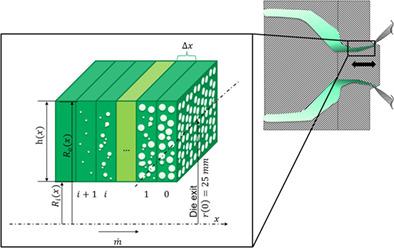当前位置:
X-MOL 学术
›
Polym. Eng. Sci.
›
论文详情
Our official English website, www.x-mol.net, welcomes your
feedback! (Note: you will need to create a separate account there.)
Modeling flow and cell formation in foam sheet extrusion of polystyrene with CO2 and co-blowing agents. Part II: Process model
Polymer Engineering and Science ( IF 3.2 ) Pub Date : 2021-09-10 , DOI: 10.1002/pen.25797 Robert Breuer 1 , Sven Hendriks 1, 2 , Nicolas Reinhardt 1 , Martin Facklam 1 , Christian Hopmann 1
Polymer Engineering and Science ( IF 3.2 ) Pub Date : 2021-09-10 , DOI: 10.1002/pen.25797 Robert Breuer 1 , Sven Hendriks 1, 2 , Nicolas Reinhardt 1 , Martin Facklam 1 , Christian Hopmann 1
Affiliation

|
In foam extrusion, process parameters, material properties, and the blowing agent have an influence on the resulting foam properties. For safety and environmental reasons, carbon dioxide (CO2) has gained importance as physical blowing agent for the production of low-density polystyrene foam sheets. The sole use of CO2 often leads to corrugation, open cell structures, or surface defects on the foam sheet. As an alternative, blowing agent mixtures based on CO2 and organic solvents such as ethanol, acetone, or ethyl acetate can be used, changing solubility and flow behavior of the gas-loaded melt. A model approach for describing foam extrusion of polystyrene with various blowing agent mixtures in an annular gap die is developed. Part I of the paper describes the modeling of material properties. In Part II, the process model including nucleation and cell formation in the flow field is developed and applied to a foam sheet extrusion process. Based on the material model, melt flow and formation of cells are modeled by a step-wise calculation along the die, showing good agreement with experimental data. Dimensionless numbers are used to describe the foaming process and a parameter study based on these dimensionless numbers is presented.
中文翻译:

用 CO2 和共发泡剂模拟聚苯乙烯泡沫板挤出中的流动和泡孔形成。第二部分:流程模型
在泡沫挤出中,工艺参数、材料特性和发泡剂对所得泡沫特性有影响。出于安全和环境原因,二氧化碳 (CO 2 ) 作为用于生产低密度聚苯乙烯泡沫板的物理发泡剂已变得越来越重要。仅使用 CO 2通常会导致泡沫板起皱、开孔结构或表面缺陷。作为替代,基于 CO 2 的发泡剂混合物可以使用有机溶剂,如乙醇、丙酮或乙酸乙酯,改变载气熔体的溶解度和流动行为。开发了一种模型方法,用于描述在环形间隙模具中使用各种发泡剂混合物对聚苯乙烯进行泡沫挤出。论文的第一部分描述了材料属性的建模。在第二部分中,开发了包括流场中成核和泡孔形成的过程模型,并将其应用于泡沫片材挤出过程。基于材料模型,熔体流动和泡孔的形成通过沿模具的逐步计算进行建模,显示出与实验数据的良好一致性。无量纲数用于描述发泡过程,并提出了基于这些无量纲数的参数研究。
更新日期:2021-10-01
中文翻译:

用 CO2 和共发泡剂模拟聚苯乙烯泡沫板挤出中的流动和泡孔形成。第二部分:流程模型
在泡沫挤出中,工艺参数、材料特性和发泡剂对所得泡沫特性有影响。出于安全和环境原因,二氧化碳 (CO 2 ) 作为用于生产低密度聚苯乙烯泡沫板的物理发泡剂已变得越来越重要。仅使用 CO 2通常会导致泡沫板起皱、开孔结构或表面缺陷。作为替代,基于 CO 2 的发泡剂混合物可以使用有机溶剂,如乙醇、丙酮或乙酸乙酯,改变载气熔体的溶解度和流动行为。开发了一种模型方法,用于描述在环形间隙模具中使用各种发泡剂混合物对聚苯乙烯进行泡沫挤出。论文的第一部分描述了材料属性的建模。在第二部分中,开发了包括流场中成核和泡孔形成的过程模型,并将其应用于泡沫片材挤出过程。基于材料模型,熔体流动和泡孔的形成通过沿模具的逐步计算进行建模,显示出与实验数据的良好一致性。无量纲数用于描述发泡过程,并提出了基于这些无量纲数的参数研究。











































 京公网安备 11010802027423号
京公网安备 11010802027423号